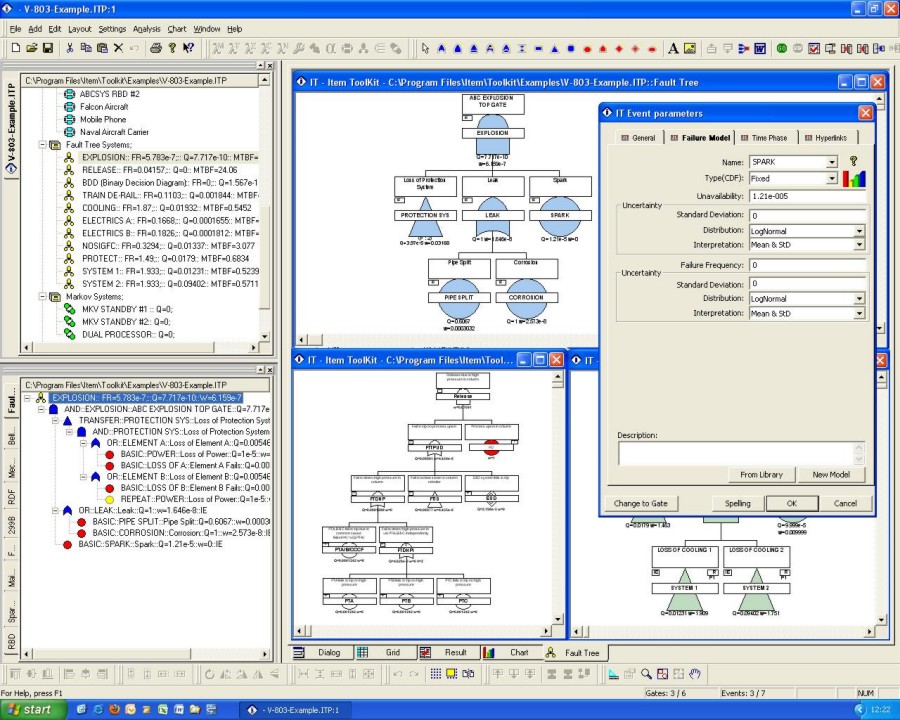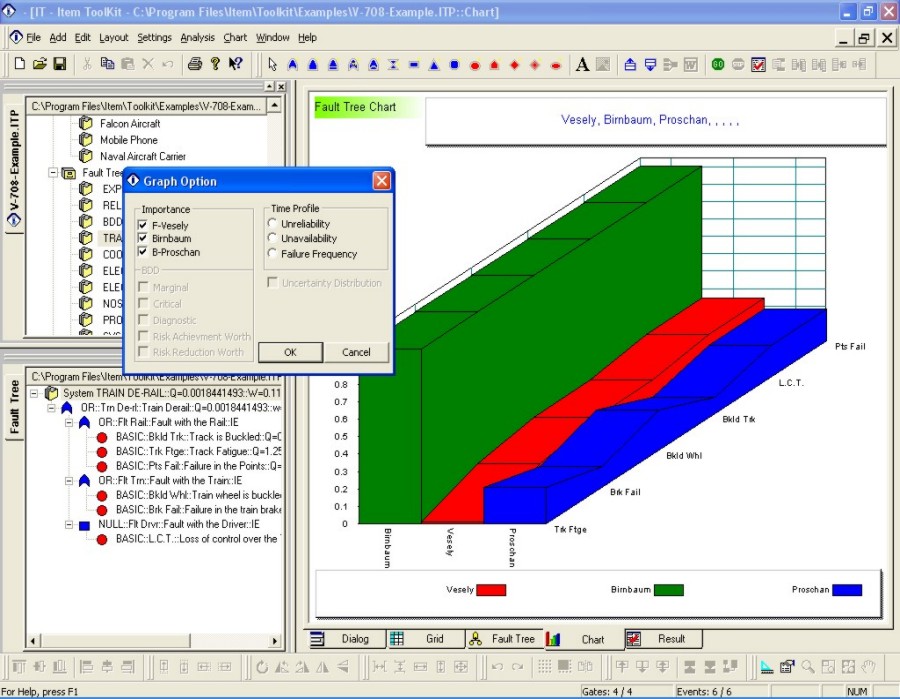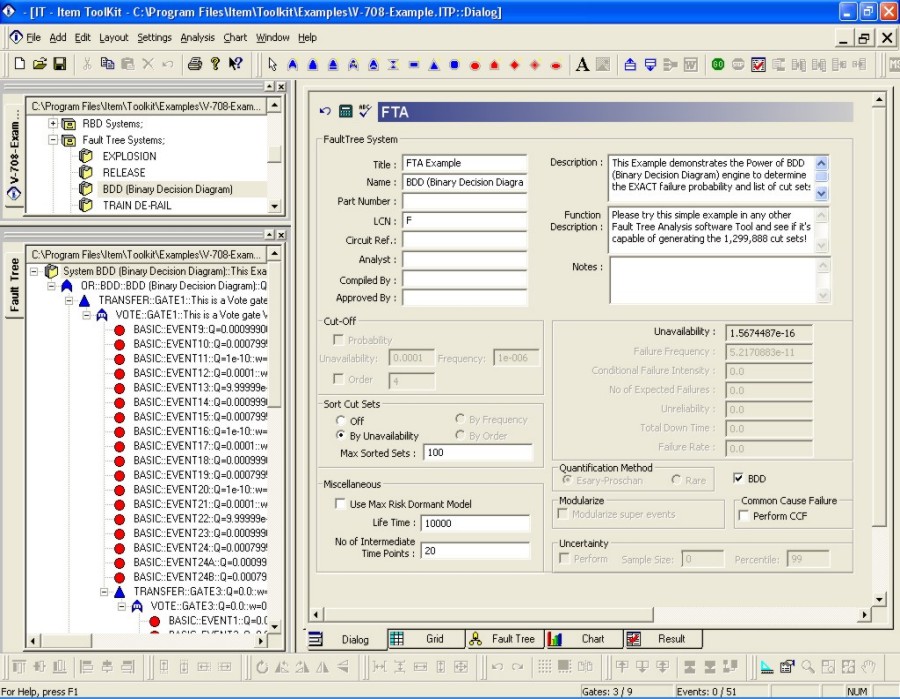
Fault Tree Module
Fault Tree Analysis Software (FTA)
Fault Tree Analysis uses tree structures to decompose system level failures into combinations of lower-level events, and Boolean gates to model their interactions.
To address safety and the ways failures or undesirable events could occur; and thereby, trying to avoid them can be very challenging. To improve system safety and reliability, designers and analysts have to make better-informed risk assessment decisions based on quantified evaluations of the risks and effects associated with alternative designs and other risk-mitigating actions.
These challenges are more compounded where manual methods of fault isolation and risk analysis in large and complex systems are not viable.
Using failure probability and system reliability data can assist you in addressing the undesirable events or challenges. Often times, Fault Trees are used in reliability and safety risk assessments to represent graphically the logical interactions and probabilities of occurrence of component failures and other events in a system.
A Fault Tree Analysis identifies and ranks combinations of events represented on a Fault Tree that cause system failure, and provides estimates of the system’s failure probability.
Using this detailed information, efforts to improve system safety and reliability can be highly focused and tailored to your individual system by using the quantitative results from the data you input. Additionally, Fault Tree Analysis can help prevent failures from occurring by providing you with data showing how and under what circumstances the failure could occur, allowing for alternative measures to prevent (or design out) the catastrophic failures or hazards.
The Boolean methodology and equations are used to construct and simplify the Fault Tree. As Fault trees are constructed, the Boolean equations are used to evaluate the Quantitative and Qualitative characteristic of a critical system.
The Qualitative analysis of the Fault Tree determines the: a) probability of system failure (top event) based on a single failure (basic event) cause or common cause potential using minimal cut sets, b) combination of component failures (minimal cut sets), c) importance ranking of contributors to system failure.
The Quantitative analysis of the Fault Tree focuses on the probabilities of system and cut set failure or the occurrence of the top event based on the probabilities of failure of the basic events.

Fault Tree Construction
ITEM ToolKit’s Fault Tree Software offers a diverse graphical user interface (GUI) flexible, powerful and easy ways for constructing Fault Trees. The GUI consists of menus, toolbars, and project and system windows. You can simply add different gates and events in the System Window to create a hierarchy of your system, ITEM ToolKit will construct the Fault Tree Diagram for you. Or, you can build your Fault Tree the traditional way by adding gates and events in the Diagram Window.

Binary Decision Diagrams (BDD)
- Are your current Fault Trees too complex to be analyzed by traditional Approximation Methods?
- Are your current Fault Trees “Non-Coherent” Fault Trees?
- Only ITEM Software can offer you the unique solution for these complex Analyses problems: Binary Decision Diagrams (BDD)
Only by using a BDD engine to solve trees such as these can offer you exact results. Approximation methods cannot be used to accurately solve “non-coherent” fault trees. Only ITEM ToolKit offers a unique flag at system level to switch between the traditional approximation method and binary decision diagram analysis.
Arrange for a Web Demonstration today to see the full benefits of ITEM ToolKit to your Organizational needs
Numerous companies are switching over to ITEM ToolKit as their trees become larger due to the inefficiency of their previous software tool.
“I didn’t realize the benefits of the Binary Decision Diagram (BDD) engine for analyzing Non-Coherent fault trees until I switched over to this solution in ITEM ToolKit. Now I’m getting results that finally make sense!”, S.D., SAFRAN
“With my previous software, the analyses of my large fault trees were taking forever and finally running out of memory and crashing. Using ITEM ToolKit BDD engine has resolved this issue dramatically and completely. The analyses take seconds instead of hours, giving me accurate results that I can rely on. Thank you ITEM.”, Anon
When it comes to SAFETY, don’t settle for Approximated Probabilities. Switch over to ITEM ToolKit Fault Tree BDD Engine today to analyze your trees quickly, efficiently and most importantly with EXACT PROBABILITIES.

Values and Features
ITEM ToolKit Fault Tree software incorporates two independent calculation engines: Binary Decision Diagram and Approximation Method. Provides methods to calculate unreliability and unavailability; analyzes Uncertainty and Sensitivity; analyzes Common Cause Failure (CCF); Produces Minimal Cut Sets; Identifies Fault Tree Sequencing, Initiator and Enabler, Initiator Only, Enabler Only; Defines event failure models; Determines the importance of elements in a system.
- Fault tree software that allows 15 failure models, 9 types of gates, 4 types of events, and 4 CCF models
- Handles multiple time phases for a single event
- Analyzes uncertainty using Latin Hypercube Sampling (LHCS)
- Converts CAFTA® models automatically
- Analyzes Importance
- Creates new projects by reusing data from other projects
- Copy and Paste Gates and Events between projects
- Simultaneously displays results and Fault Tree diagram
- Drag-and-drop Gates and Events between libraries and projects
- Displays various Gate and Event information on the diagram
- Displays various system and project information in the hierarchy windows
- Sorts Events by name, unreliability or manually
- Edits Project, System, Gate and Event information and parameters using Dialog and Grid views
- Allows changing of color and sizes of gates and events
- System navigation using system hierarchy and diagram windows
- Adjusts and resizes label and text boxes
Contact us now for a free quotation or an online demonstration.

- Fault Tree Analysis (FTA) Software
- Calculates Unreliability and Unavailability
- Analyses Uncertainty and Sensitivity
- Analyses Common Cause Failure (CCF)
- Produces Minimal Cut Sets
- Identifies Fault Tree Sequencing
- Defines Event Failure Models
- Determines Importance of Elements in a System
- Powerful Charting Facilities
- Import and Export to MS Excel, Access, Word etc.
- Multi-document Interface for Easy Data Transfer
- Links to Event Tree Module
- Advanced Hybrid Linking and Modeling
- One of Thirteen ITEM ToolKit Modules


ITEM ToolKit Modules:
- MIL-HDBK-217 Prediction >>
- Telcordia Module >>
- IEC 62380 Prediction >>
- IEC 61709 Prediction >>
- NSWC Mechanical Prediction >>
- China 299B Prediction >>
- Failure Mode, Effects, and Criticality Analysis >>
- Reliability Block Diagram >>
- Fault Tree Analysis >>
- Event Tree Analysis >>
- Markov Analysis >>
- Maintainability >>
- Spares Scaling & Ranging >>
